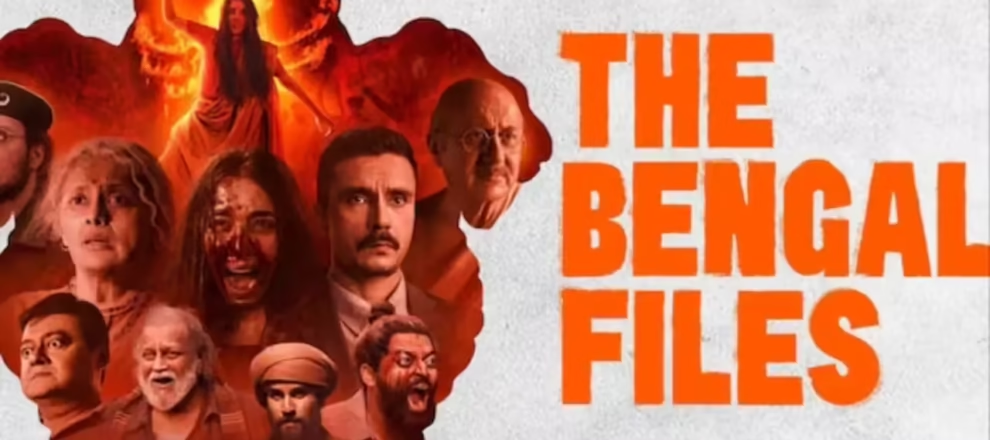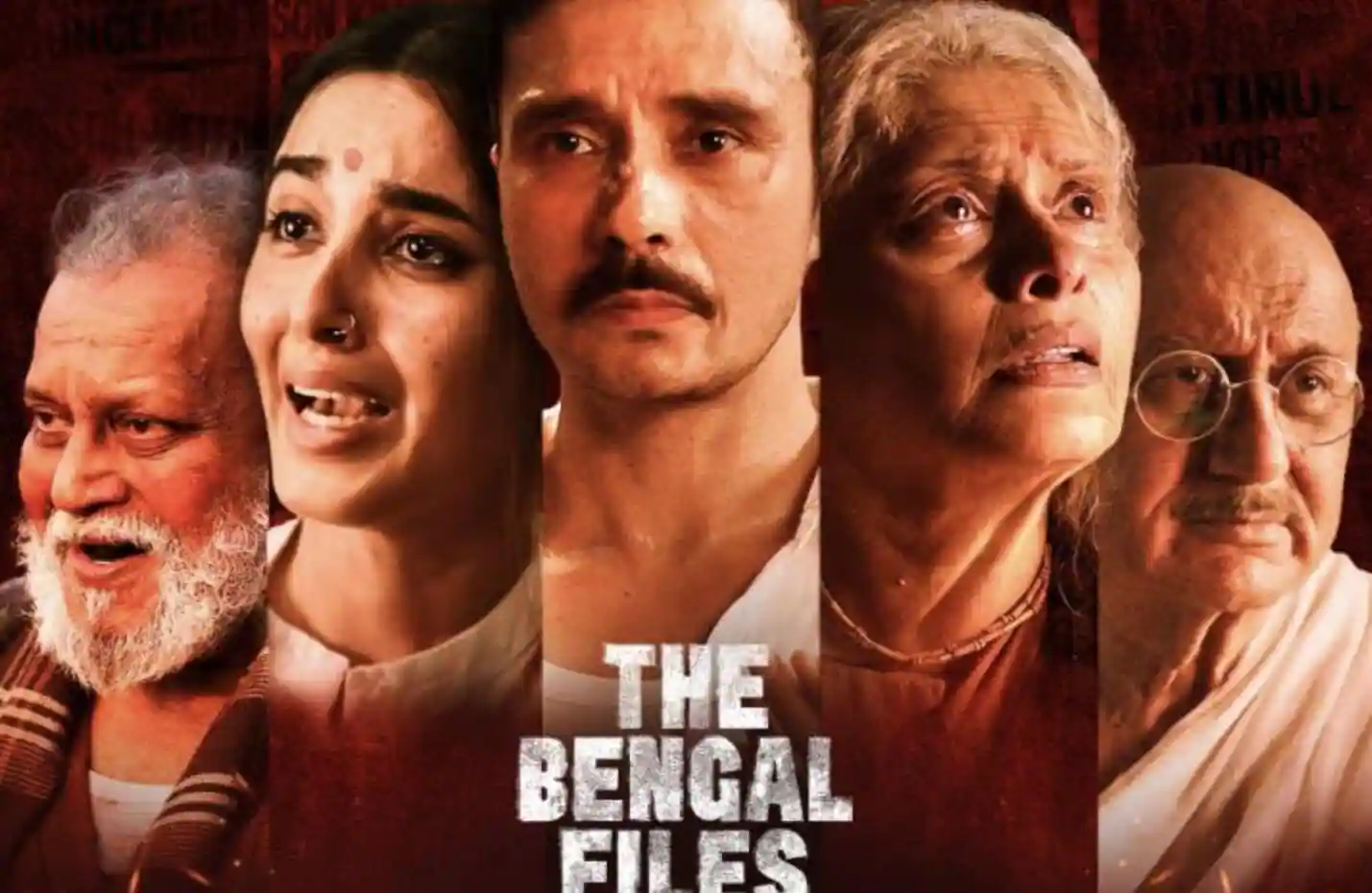The Bengal Files (2025), the final installment of his ambitious Files trilogy, following The Tashkent Files (2019) and The Kashmir Files (2022), is a film that aims to unearth a lesser-discussed chapter of India’s pre-independence history—the violent events surrounding the Direct Action Day of August 16, 1946, also known as the Great Calcutta Killings, and the subsequent Noakhali riots.
With a runtime of 204 minutes, the film is a sprawling, emotionally charged political drama that intertwines the historical horrors of 1946 with a contemporary narrative set in modern-day West Bengal.
While The Bengal Files is undeniably bold in its intent and succeeds in spotlighting a buried historical tragedy, it stumbles in execution, suffering from an overly long runtime, uneven pacing, and a tendency to prioritize provocative rhetoric over nuanced storytelling. This review delves into the film’s strengths, weaknesses, and the broader discourse it has ignited, drawing from various perspectives while critically examining its narrative and impact.
Plot and Themes
The Bengal Files operates on two timelines. The historical narrative revisits the brutal communal violence of 1946, triggered by the Muslim League’s call for Direct Action Day, which led to thousands of deaths, predominantly Hindus, in Calcutta and surrounding areas like Noakhali.
The film portrays these events as a genocide, focusing on the suffering of the Hindu community and the role of figures like Gopal Chandra Mukherjee, a local strongman credited with resisting the violence. The modern-day storyline follows CBI officer Shiva Pandit (Darshan Kumar), who investigates the disappearance of a Dalit girl, Gita Mandal, in Murshidabad.
His investigation leads him to Bharati Banerjee (Pallavi Joshi), an enigmatic elderly woman whose knowledge of the past connects the missing girl’s case to the historical atrocities of 1946.
The film’s central theme is the “Right to Life,” a phrase echoed in its original title, The Bengal Files: Right to Life. Agnihotri uses this framework to argue that the communal violence of 1946 and the socio-political issues in present-day West Bengal are interconnected, suggesting that the wounds of Partition remain unhealed.
The narrative draws parallels between past and present, critiquing what it portrays as minority-driven politics and illegal migration in modern Bengal, while also questioning the erasure of these events from mainstream historical discourse. The film’s promotional material describes it as “the most researched and painful Indian film of all time,” a claim that resonates with some viewers but has drawn skepticism from others.
The Bengal Files Strengths
One of The Bengal Files’ most significant achievements is its willingness to confront a historical event that has been largely glossed over in Indian education and public memory. The Direct Action Day and Noakhali riots are harrowing chapters of India’s Partition history, and the film’s unflinching depiction of the violence—heads decapitated, bodies mutilated—shocks the viewer into acknowledging the scale of the tragedy.
The performances, particularly by Mithun Chakraborty as Chatur, a mute survivor of the riots, and Pallavi Joshi as Bharati Banerjee, are standout elements. Chakraborty brings a haunting gravitas to his role, though his character’s lack of clear dialogue due to a severed tongue sometimes hampers emotional connection. Joshi, meanwhile, delivers a steely, layered performance that anchors the film’s dual timelines, potentially earning her award consideration, though the polarized reception may hinder this.
The film’s technical aspects also deserve praise. Attar Singh Saini’s cinematography captures the chaos of 1946 Calcutta with vivid authenticity, and the 1940s sets are meticulously crafted, immersing viewers in the era. Rohit Sharma’s background score, combined with traditional songs like Kichudin Mone Mone by Parvathy Baul, adds emotional depth, particularly in the historical segments.
The action sequences, choreographed by Paramjeet Singh Dhillon, are visceral and realistic, amplifying the film’s raw intensity. For audiences unfamiliar with this history, The Bengal Files serves as a jarring wake-up call, highlighting the sacrifices and suffering of those caught in the Partition’s crossfire.
The film’s supporters, particularly on platforms like BookMyShow and X, have lauded its courage in tackling a “forgotten Hindu genocide.” Reviews from international audiences describe it as “gut-wrenching” and “hard-hitting,” with some calling it a “must-watch” for its portrayal of historical truths suppressed by “secular” narratives. These reactions underscore the film’s ability to resonate emotionally with viewers who feel that mainstream media and academia have sidelined these events.
Weaknesses
Despite its noble intentions, The Bengal Files falters in several critical areas. The most glaring issue is its runtime, which at 204 minutes feels unnecessarily protracted. The film’s non-linear storytelling, while ambitious, often confuses the audience with its multiple plotlines and characters, many of which lack proper resolution.
The modern-day narrative, in particular, feels underdeveloped and fails to match the intensity of the historical segments. Critics have noted that the film’s attempt to link past and present—comparing 1946 Bengal to contemporary issues—comes across as forced, diluting its emotional impact.
The screenplay, penned by Agnihotri, is another weak point. It prioritizes lengthy monologues and moral absolutes over subtlety, framing the narrative in stark binaries of heroes and villains. This approach sacrifices historical nuance for emotional manipulation, portraying the Hindu community as victims while casting Muslims as aggressors with little exploration of the complexities of communal violence.
For instance, the film absolves British colonial officers of significant responsibility and depicts the Congress as weak, while lionizing figures like Gopal Mukherjee without providing sufficient context. Critics like Anuj Kumar from The Hindu have accused the film of using cinema as a “tool to divide,” arguing that it inflames majoritarian sentiments rather than fostering understanding.
The performances, while generally strong, are inconsistent. Anupam Kher’s portrayal of Mahatma Gandhi is restrained but lacks depth, and some supporting roles feel perfunctory. The film’s pacing suffers from excessive dialogue and redundant scenes, particularly in the first half, which could have been trimmed to enhance impact.
On Rotten Tomatoes, the film has received a mixed response, with only two of six critic reviews being positive, citing issues like “incoherent writing” and “poor editing”. Mukund Setlur’s review in Deccan Herald calls it a “double-edged disaster,” highlighting its failure to balance fact and fiction.
Controversy and Reception
The Bengal Files have been mired in controversy since their announcement. Originally titled The Delhi Files: Bengal Chapter, the film underwent a title change after public feedback, reflecting Agnihotri’s responsiveness to audience sentiment. However, the trailer launch in Kolkata was halted by police, prompting accusations of political censorship from Agnihotri, though these claims were later debunked.
Actor Saswata Chatterjee, who plays an antagonist, distanced himself from the controversy, claiming he was unaware of the title change and emphasizing his role as an actor, not a historian. Producer Pallavi Joshi countered that Chatterjee was fully informed, suggesting he faced political pressure.
The film’s box office performance has been underwhelming, grossing ₹12.26 crore worldwide against a ₹35–40 crore budget, earning less than a third of its cost in the first week. This commercial failure contrasts with the success of The Kashmir Files, which benefited from stronger word-of-mouth and less competition. The Bengal Files faced stiff competition from Baaghi 4 and The Conjuring: Last Rites, which likely impacted its performance. Audience reactions to X are polarized, with some praising its “unapologetic” depiction of history, while others dismiss it as “pretentious” and “overly dramatic”.
Critical Analysis
The Bengal Files is a film that provokes more than it persuades. Its strength lies in its courage to address a neglected historical tragedy, but its execution undermines its potential. By prioritizing sensationalism over nuance, the film risks alienating viewers who seek a balanced exploration of history.
The lack of focus on ordinary Muslim households affected by the violence and the one-sided portrayal of communal dynamics invite accusations of propaganda. While the film claims to be well-researched, its selective framing raises questions about historical accuracy, particularly in its depiction of figures like Huseyn Shaheed Suhrawardy and Mujibur Rahman.
For viewers familiar with Agnihotri’s previous work, The Bengal Files feels like a continuation of his brand of confrontational storytelling. However, it lacks the narrative coherence and emotional resonance of The Kashmir Files. The film’s attempt to connect 1946 to 2025 feels heavy-handed, and its political undertones—suggesting Bengal is the “new Kashmir”—may resonate with some but alienate others who see it as divisive. As Filmfare notes, those who enjoyed the Files trilogy may appreciate its intensity, but sticklers for historical accuracy will find much to critique.
Conclusion
The Bengal Files is a film that demands attention for its subject matter but struggles to deliver a cohesive and impactful narrative. Its powerful performances and technical strengths are overshadowed by a bloated runtime, uneven pacing, and a polarizing approach to history. While it succeeds in sparking debate about the Direct Action Day and Noakhali riots, it falls short of being a definitive cinematic exploration of these events.
For those interested in India’s Partition history, the film offers a starting point but should be approached with a critical eye, supplemented by further reading to contextualize its claims. Ultimately, The Bengal Files is a commendable but flawed attempt to illuminate a dark chapter, leaving viewers both moved and divided.
Recommendation: Watch it for its historical focus and strong performances, but be prepared for a long, emotionally heavy experience that may not fully satisfy in terms of storytelling or historical nuance.


